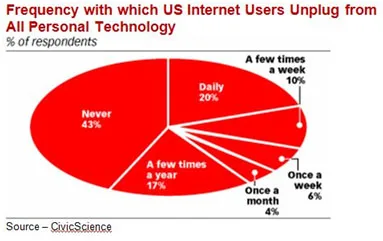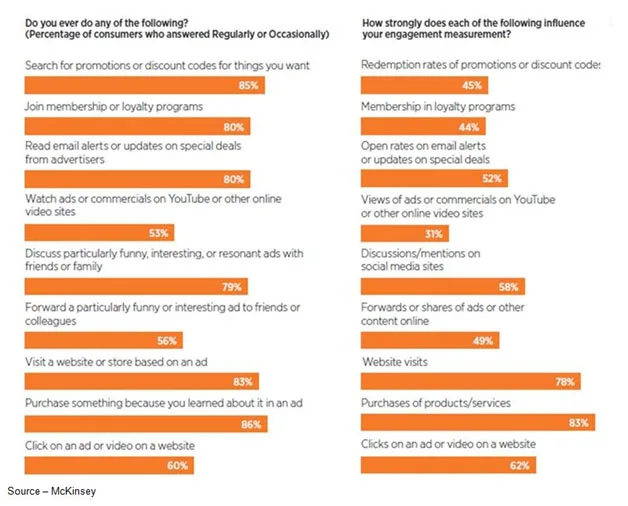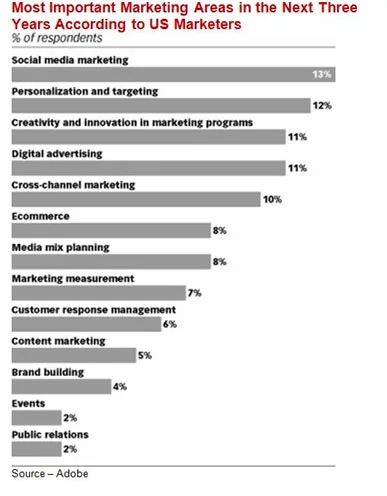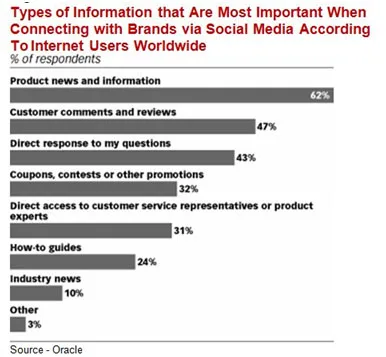It’s All About the Consumer, Not Social Domains

Businesses are running so fast today trying to catch the next great thing, they’ve lost sight of the reason they’re in business … the customer.
They’re setting up departments to handle the internet, to handle individual segments of the Web, IoT (Internet of things) and IoE (Internet of Everything).
They’ve become so compartmentalized, so departmentalized that all they’re seeing is what they do and how they do it, rather than why in hell are we doing this!
Suddenly, the organization is overflowing with experts in whatever, telling us how well their thingie connects, engages with the consumer.
They’re quick to tell you how important their activity is to the growth, success of the company.
Like wolves, the first thing they do is establish/mark their turf!
You probably see it in your own company.
Simply put – The Internet of Choices will kill businesses.
Every time there’s a new “opportunity” to reach out, grab a customer, companies set up new departments of skilled people to leverage the opportunity for … more sales.
Let’s run the numbers:
- 7B+ people on the planet
- 4500+ firms listed on global stock exchanges
- 125M + companies globally
- 99% of the firms are SMBs (small-medium businesses)
That means there are 56 customers (assuming everyone gets their fair share) that they can identify, reach, inspire.
How hard can that be?
Obviously, pretty hard.
It shouldn’t be because according to a recent CivicScience report, most of us are nearly always connected, can always be reached.
 Always Connected – “Normal” people stay connected nearly round-the-clock/calendar but it doesn’t mean they’re waiting to like your marketing messages, retweet your pearls of wisdom, check out your poster ads or even spend a bunch of time with you … except with they’re ready to buy something. Mass social media efforts fall short and so does the compartmentalization of your experts.
Always Connected – “Normal” people stay connected nearly round-the-clock/calendar but it doesn’t mean they’re waiting to like your marketing messages, retweet your pearls of wisdom, check out your poster ads or even spend a bunch of time with you … except with they’re ready to buy something. Mass social media efforts fall short and so does the compartmentalization of your experts.
Whether it’s an iPod, ereader, laptop, desktop, smartphone, tablet or TV, 60 percent of us folks are almost always connected, 40 percent of us never unplug and only about 17 percent really take a break.
And it isn’t just passive.
Our IP (internet protocol) address, social media pages and the thousands of free/freemium apps we download/use tell companies more than we probably want them to know about us and still … they can’t hit the target.
 Should Be Easier – There’s enough information out in the wild and in your customer databases to zero-in on a specific customer’s wants/needs; and while we give 1:1 communications lip service, few experts don’t want to bother doing the extra work.
Should Be Easier – There’s enough information out in the wild and in your customer databases to zero-in on a specific customer’s wants/needs; and while we give 1:1 communications lip service, few experts don’t want to bother doing the extra work.
Marketers sorta’ try with behavioral targeting – if someone looks at something but doesn’t buy, show them a relevant ad to give them “another chance.”
If they buy, show them another product that will enhance their purchase experience.
It beats the heck out of garbage (even targeted stuff) filling your inbox every time you turn around.
The problem is people:
- Don’t buy your product for your design, your image of what it will do
- Don’t care about your content, your Facebook wall, your Tweets
They make buying decisions for emotional reasons – the why of the company that aligns with their personal why – and use the logical reasons – what it is, how it works to justify those decisions
Fundamentally, they buy you first and your product second because you resonate with them.
 Priorities – It’s embarrassingly funny that marketing people weigh the importance and value of consumer contact more than the individual does. But it’s difficult to understand individuals and what they expect when you don’t get out and talk with them.
Priorities – It’s embarrassingly funny that marketing people weigh the importance and value of consumer contact more than the individual does. But it’s difficult to understand individuals and what they expect when you don’t get out and talk with them.
Unfortunately, marketing folks think consumers are more into company/product engagement than they really are.
Just because folks are following your social media stuff, it doesn’t say your marketing is successful–you don’t know what you don’t measure.
People are smarter than marketing/communications types give them credit for because to them, customized, personal means … customized and personal!
As long as the relationship is a true reflection of them, they’ll hang around.
When your social media/ad messages don’t meet their whole self image … BAM!! Outta’ here!
Don’t believe marketing is “disconnected”?
Consider the fact that 49 percent of guys/gals who hustle this stuff think that ad forwards/shares have something to do with how well they’re engaging with folks.
Consumers? Oh about 15 percent think they have any skin in the game when they share an ad.
So much for that happy face on the Tweet report you send to your boss.
 Loading Up – Every new great idea that emerges in the social media and customer contact fields are quickly added to many marketing teams’ growing arsenal of tools. Customers want a simple, single view of the company and they want seamless discussions across the organization.
Loading Up – Every new great idea that emerges in the social media and customer contact fields are quickly added to many marketing teams’ growing arsenal of tools. Customers want a simple, single view of the company and they want seamless discussions across the organization.
All it says is that consumers are people (creatures of habit) and they come back sorta’, kinda’ without thinking but they want something in return.
That’s right; consumers aren’t into all the social media just because it’s in vogue right now.
More than anything, they want to know you understand them; so pull up your big boy/girl pants and develop an experience that matches their tastes … not yours.
If they’re a hardcore gamer, give ‘em the images, talk to them in their tough-as-nails action language.
If they’re a creative person who produces brilliant video content, then be sophisticated instead of using the screaming weekend specials approach.
So there’s a huge divide between consumers, companies/brands/products; and the marketers wonder why their connection with the consumer is so fleeting.
Nothing personal, but your engagement efforts aren’t personal.
 Different Needs – Consumers are only peripherally aware of company social media and other communications activities until they are interested. Then they begin their search for the decision-making information they expect to find … quickly, easily. If they can’t find it instantly, they move to a better company, better product.
Different Needs – Consumers are only peripherally aware of company social media and other communications activities until they are interested. Then they begin their search for the decision-making information they expect to find … quickly, easily. If they can’t find it instantly, they move to a better company, better product.
People on the hunt for a product or service visit your site or stop by your social media activities for a variety of reasons and check a few very key items.
If you don’t have them, you must have something to hide or you simply don’t give a crap and are way into your brilliant social media work!
A McKinsey report released a couple of years ago said that the average company had more consumer data in their CRM (customer relations management) database than the Library of Congress.
Heck, more people in Facebook, Google, LinkedIn, Pinterest, and Twitter are in sales than in mining the information they scrape.
No need … there’s an app for that.
Not that people mind – hey, Gmail is “free”, the Facebook/LinkedIn brag pages are “free” – it’s just that folks want you to understand what their needs/wants are … not yours … or yours … or yours.
It’s not about the individual silos of social media (and we all have our favorite that we swear is where the real action is), advertising, shows/events, publicity or any of the individual marketing/communications tools.
It has to be a totally integrated effort that moves smoothly, seamlessly across every outreach, contact activity and shares information across all segments of the organization. Why?
Jeezz folks, it’s all about/for the customer, not insignificant silos!
 In/Out Fast – Despite the engineering logic and carefully crafted marketing messages, consumers continue to make their buying decisions based on information that resonates with them. They make buying decisions based on a combination of emotional/logical information. When it works, they line up at the cash register.
In/Out Fast – Despite the engineering logic and carefully crafted marketing messages, consumers continue to make their buying decisions based on information that resonates with them. They make buying decisions based on a combination of emotional/logical information. When it works, they line up at the cash register.
In the McKinsey report cited earlier, 40 percent of the company execs didn’t have a clue as to their digital program owners, targets or how it was being measured, held accountable.
If you don’t have clue and/or don’t want to own up to it; perhaps the money, time and people could be used more effectively somewhere else.
You know, like somewhere else in the customer buying process cycle.
Or, from management’s perspective … the selling process.
Selling isn’t an entity separate from marketing, social media, communications or other internet tools.
The Internet/web just made it tougher because you can’t give ‘em your 15-second elevator pitch anymore.
We’re now told you have six seconds to engage/interest the consumer. That means creating the right content for the right consumer on the right platform at the right time.
Preferably … now!
 In a world that is increasingly commoditized, if you don’t focus on the job that’s most important consumers will simply cut you off.
In a world that is increasingly commoditized, if you don’t focus on the job that’s most important consumers will simply cut you off.
# # #